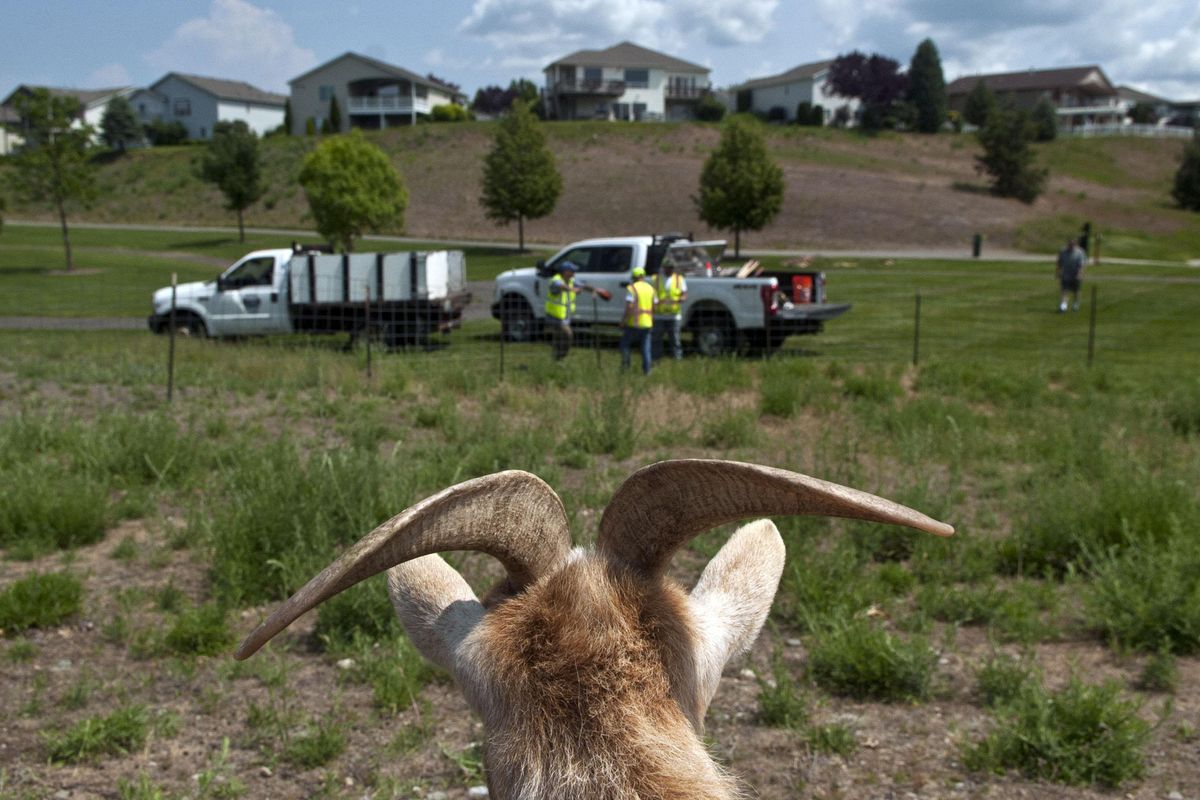To reduce weeds, Liberty Lake bought its own goat herd. Now the animals are minor celebrities.

A herd of munching mowing machines wander around their pen near a local arboretum. They are Liberty Lake’s very own goats.
The city 15 miles east of Spokane has been using goats to address noxious weeds in its parks and on difficult terrain for years.
Initially, the city rented goats. But in 2012, Jennifer Camp, the city’s operations and maintenance director, bought two goats.
“We decided we could manage our own goat herd,” Camp said.
In 2014, the city purchased four goats. Then Camp inherited goats that had been abused but rehabilitated by locals.
Currently, 10 goats are used at Liberty Lake parks and the arboretum.
The goats live with Camp during the winter, then are out in various areas around the community eating weeds from Memorial Day to Labor Day.
Street maintenance workers, like Stephen Williams, the street section lead, care for the herd.
“They eat weeds and entertain the kids,” Williams said.
Williams and his team set up goat pens in the next planned location, then wrangle the goats and transport them to the new location.
The herd is often separated into smaller groups to target specific areas. For a while after arriving in a new pen, the goats are skittish, Williams said.
Camp has presented her program to the Spokane County Noxious Weed Board and hopes other communities might start similar programs.
“The cost of having the goats is not necessarily less expensive than pesticides,” Camp said. “It’s about the same, but the environmental benefit far outweighs having to apply pesticides in these areas, particularly where it’s in public.”
Having the goats work on the same areas year after year decreases the weed population, Camp said.
When noxious weeds produce a seed and a goat eats it, the goat’s system breaks it down and neutralizes the seed. A weed can still grow from a seed that has passed through a cow’s or horse’s system, making goats unique, Camp said.
The goats are a “win-win” situation for Camp and her department, making the space safe for the general public, being environmentally friendly, tackling the weed problems, and providing a new city mascot.
“We don’t want to freak the public out, because there is a time and a place for pesticide use,” Camp said. “Pesticides are not a negative, but we do try to use them as a last resort.”
While the goats are friendly and considered city mascots, they are there for a purpose, she said, adding, “We do have citizens who look at them as pets.”
City crews supplement-feed the goats early every morning, along with providing them fresh water, she said.
The use of goats in roadside management has gained research interest nationally in recent years, said Raymond Willard, roadside maintenance program manager for the Washington State Department of Transportation.
The WSDOT conducted a study in 2016 on utilizing goats in hard-to-reach areas that are difficult to maintain. For most of the areas Willard studied, utilizing a goat herd was not as cost-effective or efficient as utilizing power tools and chemical treatments.
“If the price point came down, we would use them more, but it would be in only very specific locations where it made sense,” said Willard.
The goats can be a distraction on roadsides, but they have been used effectively in the city of Seattle, said Willard.
Liberty Lake’s goats work hard on the weeds, but are also local celebrities.
“They’re fairly famous in this town,” Camp said.
The goats have become an unofficial mascot for Liberty Lake, with the city arts and parks council putting out a call to artists for goat statues.
The call has been extended through June 30, and the art will hopefully be installed in September, said Laura Frank, a member of the Parks and Arts Commission.
“The goats have been present in our community for so long now that it’s kind of been adopted as the unofficial mascot of Liberty Lake,” Frank said.
The commission requested two life-sized pieces, but is open to artists’ ideas.
“The idea behind it is really to just enhance the experience that our citizens and our visitors have in our parks,” Frank said.